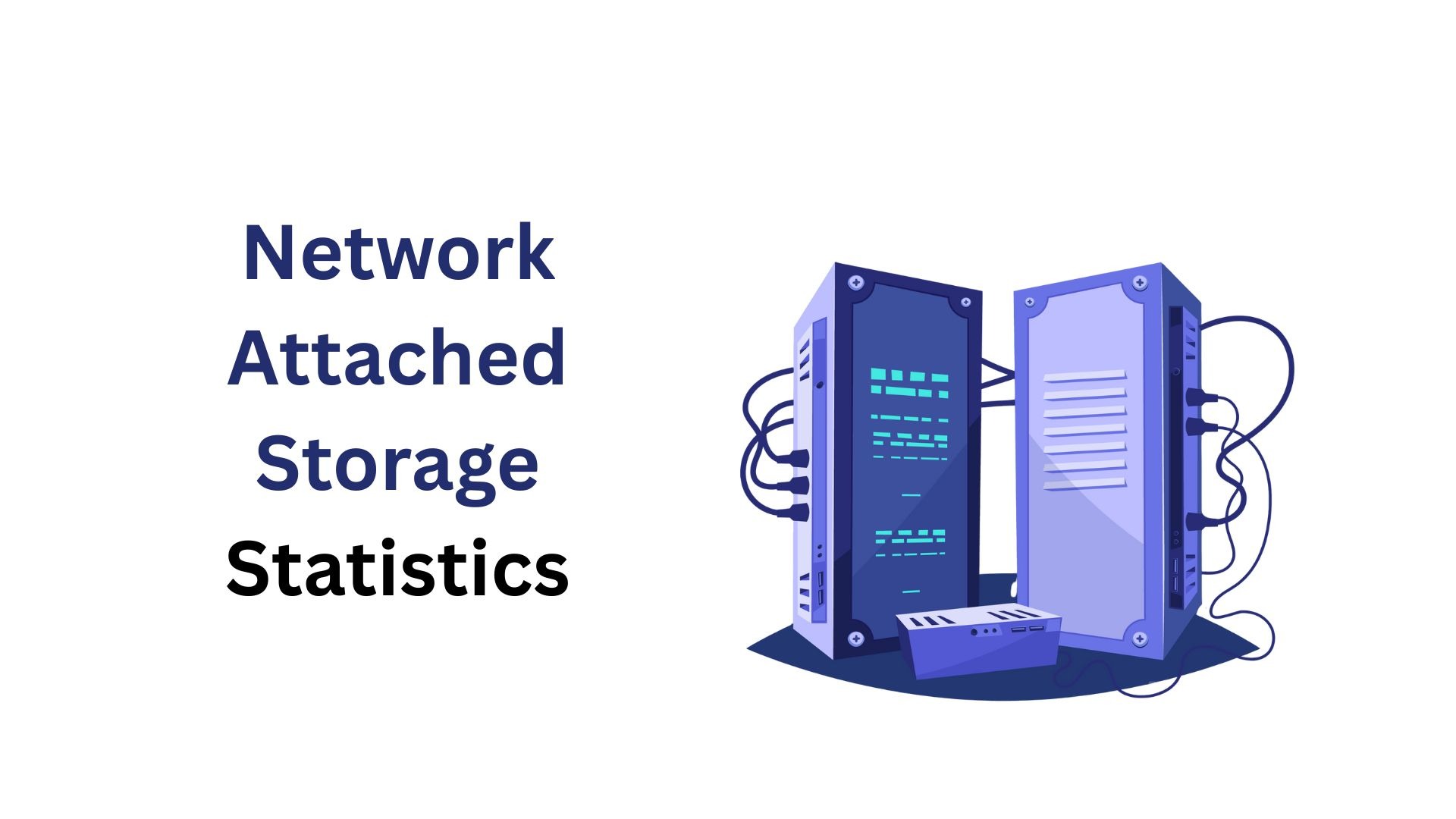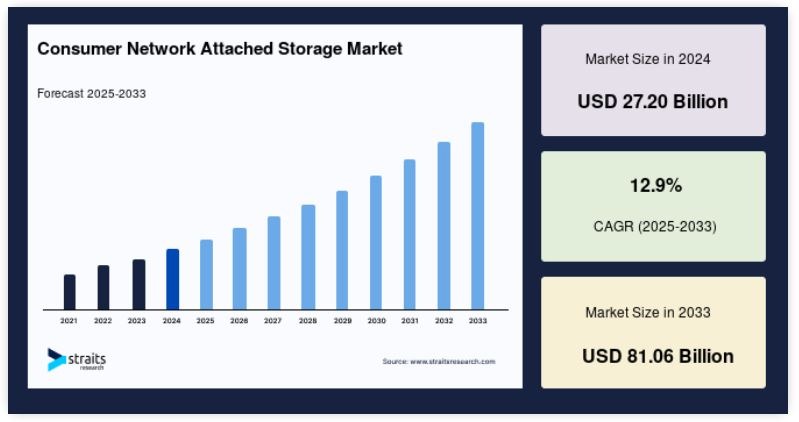Network Attached Storage Statistics And Facts (2025) | By Market Share, Industries, Growth, Vendors, Top Startups, Developments
Updated · Sep 26, 2025

Table of Contents
Introduction
Network Attached Storage Statistics: We live and work in quite a digital world where data comes into being at an accelerated pace. Companies big and small rush to keep pace. NAS is an extraordinary storage solution that offers centralised and cost-effective storage based on growing data management needs. From petabytes of highly confidential information to be handled in large enterprises to methods of efficient and secure storage in small and medium businesses, NAS is fast becoming the backbone of new-age IT infrastructure.
Having NAS is now the need of the hour, with the global NAS market estimated to triple by the year 2033 in value, driving innovation, collaboration, and digital transformation. In this article, we will present the latest Network Attached Storage Statistics regarding market trends and developments.
Editor’s Choice
- The consumer market for NAS was valued at US$27.20 billion in 2024 and is projected to hit US$81.06 billion by 2033, registering a CAGR of 12.9%.
- 80% of mid-sized and large companies are using NAS at present, overtaking DAS and SAN.
- In industries generating extreme data needs, manufacturing accounts for 966 PB, government for 848 PB, and communications/media for 715 PB.
- NAS usage is on the rise in small and medium enterprises for further cost benefits and centralised storage options.
- Hybrid NAS-cloud storage set-ups are rapidly developing, merging local control with cloud flexibility. The HPE reported US$29.1B revenue with a 5.5% constant growth rate, while Huawei generated revenues of CNY 456.6 billion during the first three quarters of 2023, with a net profit margin of 16%. Seagate Technology’s revenues have decreased drastically to US$6.80B, down 35.71% YoY, while NetApp stands at US$6.36B in 2023, growing by 0.7% from 2022.
- QNAP noted an annual revenue of US$324M in 2023, while Panasas Inc. generated US$31.5M in 2022.
- Nasuni has raised US$219M so far, with clients that include Hikma, Ramboll, and Bluebirdbio, and ranks No. 1 among 27 companies.
Network Attached Storage Market

(Source: straitsresearch.com)
- The consumer network-attached storage (NAS) market was determined to be worth US$27.20 billion in 2024. It is forecast to maintain steady growth at a compound annual rate of 12.9% between 2025 and 2033, translating into the Market expanding yearly on average at this pace.
- Consequently, with this increase, by the time the year 2033 comes, the market would have more than tripled in size to reach an estimated US$81.06 billion.
- About 80% of medium and large companies use NAS for some of their storage requirements, making it a more widespread technology than DAS or SAN.
- With the huge explosion of unstructured data, widespread expansion of IT platforms, and the conversion towards software-defined NAS and network virtualisation, the industry is buoyed up.
- Nowadays, many organisations request custom NAS to meet their unique data challenges and are increasingly adopting hybrid solutions that combine on-premises NAS with cloud-based storage.
- This combination permits the organisation to maintain direct control of its core data while using cloud services for backup and archiving.
- Vendors gain additional improvements in NAS in the form of facilitation of integration with cloud services like Amazon S3 for augmenting storage capacity and flexibility.
- While DAS remains popular for its cost and storage size, NAS has its distinct advantages when the storage has to be accessed by multiple devices or users.
- In specific scenarios, NAS can even prove more efficient than SAN, depending on the kind of network traffic or storage protocols employed.
Data Stored Across Various Industries
| Industry |
Amount of Data Stored (PB)
|
| Education | 269 |
| Retail | 364 |
| Healthcare | 434 |
| Banking | 619 |
| Communications/Media | 715 |
| Government | 848 |
| Manufacturing | 966 |
(Source: straitsresearch.com)
- Each sector handles huge amounts of stored data, and that is what the chart seeks to depict for each sector.
- Educational institutions store 269 PB of data, with student records, research files, and digital learning materials being some of the factors that contribute to such an amount.
- Retail, with sales transactions, customer data, and supply chain data, probably stores 364 PB.
- Healthcare records the stay above by about 434 PB, with patient records, medical imaging, and research data as data types.
- Banking holds in storage volume at about 619 PB, being dominantly financial transactions, compliance, and security data.
- Communications and media sectors are managing around 715 PB, which includes video materials, audio contents, and digital content libraries.
- Government organisations store nearly 848 PB, covering records of citizen data, defence, and public services.
- Manufacturing is the largest one with 966 PB, considering industrial IoT systems, production data, and design files, which altogether create the need for massive storage.
- So putting these together is to spell out how big data creation is across industries and why efficient storage systems like NAS are needed now more than ever.
Key Growth Drivers Of NAS
- Another driver behind the rapid expansion of the NAS market is the increasing adoption by SMBs across various industries.
- These businesses opt for NAS systems as an affordable way to centralise their data for easy backup, access, and sharing with less reliance on a large IT team.
- Employees can also connect to the system remotely, thus enhancing collaboration, customer service, and competitiveness.
- Furthermore, an increased hybrid cloud storage adoption rate stands as another prime factor.
- With more unstructured data, such as videos, images, and audio files, being created, businesses require efficient ways to store it securely.
- A hybrid NAS scheme combines local NAS devices with cloud storage, allowing the organisation to build a unified database accessible from anywhere.
- That eventually helps companies manage their increasing data needs, and deciding on a hybrid NAS now offers them greater appeal.
The Major NAS Marketplace Vendors
- Several leading technology companies partake in this NAS market, each bringing with it a different set of strengths and financial performance reports.
- Hewlett Packard Enterprise (HPE), for example, reported revenues of US$29.1 billion, showing a 2.2% revenue increase over the preceding year, with constant growth in revenues at 5.5%.
- Hitachi, on the other hand, faced decline; its revenues for the twelve months ending 30 June 2023 measured at US$57.04 billion, down 30.48% year on year. Its total revenue was US$80.52 billion in 2023, a decline of 11.86% from 2022.
- Huawei delivered stronger numbers with revenue reported at CNY 456.6 billion for the first three quarters of 2023, up by 2.4%, while maintaining a sturdy 16% net profit margin.
- IBM, too, saw reasonable growth at US$61.17 billion in revenue for the twelve months ending September 2023, its revenues witnessing a 1.05% increase, after having risen by 5.54% in 2022 compared to 2021.
- Turning to Seagate Technology, the trends were much different, with revenues of US$6.80 billion for the twelve months ending in September 2023, down 35.71% year on year, and annual revenues for 2023 of US$7.38 billion, down 36.68% compared to 2022.
- NetApp posted US$6.20 billion in revenue for the twelve months ending July 2023, down 3.87% from last year, with sales actually showing a slight 0.7% rise over 2022 as the company recorded US$6.36 billion in 2023.
- NETGEAR posted revenues of US$801.27 million in the twelve months ending October 2023, against a 14.26% decline, when its quarterly revenues were US$197.85 million, down 20.73% year-over-year.
- Infortrend remains active globally, with offices in various regional locations since it is headquartered in New Taipei, Taiwan. In 2023, QNAP Systems generated US$324 million in annual revenue, whereas Panasas Inc. generated US$31.5 million in 2022.
Top NAS Startups
Nasuni
- Nasuni is an American cloud enterprise file system vendor formed in 2009 and situated in Natick.
- The company offers cloud-based NAS services through its proprietary UniFS file system that arranges hardware and cloud storage on a subscription basis.
- Services include management consoles, data security, backup, and WAN acceleration. Some of the more prominent customers include Hikma, Ramboll, Ulteig, and Bluebirdbio.
- To date, Nasuni has raised US$219 million across various rounds, the latest one being in July 2024 through Series F.
- The company has prominent backers such as North Bridge Venture Partners and Flybridge Capital Partners; the company holds the highest Tracxn score (69/100) in the state of competition among 27 runners.
QNAP
- Founded in 2004 in Taipei, QNAP is a public company and a leading supplier of enterprise network appliances.
- Its solutions include NAS storage, NVR video surveillance, and network video players in both the consumer and enterprise markets.
- International Screen Academy and Delta Vision fall under its client list. It holds a Tracxn score of 56/100 and is ranked first among 66 competitors.
Synology
- Established in 2000 in Taipei, Synology is a bootstrapped company famous for designing rack servers and NAS platforms to serve enterprises.
- It also offers products for data management, surveillance, and duplication.
- Synology, with its reputation as one of the top NAS vendors globally, has a Tracxn score of 55/100, placing it second among 85 competitors.
Spinnaker Networks
- Established in 1999 in Irvine, Spinnaker Networks offered NAS solutions built on SpinFS, a distributed file system with a focus on cost-effective multi-server management.
- Acquired by NetApp, the technologies of Spinnaker were then integrated into NetApp’s Storage Grid Architecture.
- Before acquisition, they raised US$51.4 million, with US$31 million raised in Series B funding in 2002. It has a Tracxn score of 54/100.
Asustor
- Established in Taipei in 2011, the company is into private cloud NAS solutions for SMBs.
- It currently offers data monitoring and backup software with growing surveillance solutions.
- The Tracxn score of 50/100, being public, reflects steady competitiveness.
Latest Developments
- In April 2023, Seagate and QNAP announced a partnership for the launch of an integrated portfolio that couples Seagate’s IronWolf Pro hard drives with QNAP’s NAS systems to offer enterprise-level edge-to-cloud storage solutions to businesses managing large datasets.
- StorCentric introduced something called Nexsan EZ-NAS in June 2022. It is a bespoke 1U-edge system, having a capacity of 72 TB and capable of processing data at 1.5 GB/s, making it suitable both for extremely small and large enterprises.
- OpenDrivesmanoeuvred a US$20 million Series B in January 2021, led by IAG Capital Partners, to enhance product development in HPC and hybrid cloud technologies.
- July saw QNAP quashing a high-severity vulnerability in its Hybrid Backup Sync system, promptly reassuring its customers about the sanctity of their data from being arbitrarily accessed.
- On the other hand, 2023 was a year of innovation for Western Digital in enhancing its product portfolio with stronger enterprise features to better serve the growing demands of large-scale datasets.
Conclusion
Network Attached Storage Statistics: The Network Attached Storage (NAS) is currently in an emphatic growth stage, driven chiefly by the exponential rise of unstructured data and the need for cost-effective and scalable storage solutions. As industries generate massive petabytes of information, the relevance of NAS is massive for both enterprises and SMBs. By incorporating aspects of security, flexibility, and accessibility, hybrid NAS-cloud models generally empower the infrastructure of contemporary IT.
In the realm of competition provided by cloud-only solutions, continuous innovations coming from leading vendors and startups ensure that NAS remains key to data management strategies and, therefore, an indispensable technology for prospering in the digital economy of tomorrow.
Sources
FAQ.
NAS is a centralised solution that allows multiple users and devices to access data over a local network. It facilitates file sharing, backups, and collaboration while making it an option for the enterprise as well as for the small business sector.
Unstructured data is increasing, with hybrid cloud storage requirements and centralised solutions at cheaper costs being the foremost issues creating demand for NAS worldwide.
Manufacturing (966 PB), government (848 PB), and communications/media (715 PB) are among the top industries generating massive storage needs.
In contrast to a DAS, a NAS allows multiple users to access data at the same time, whilst a SAN offers greater setup and cost efficiency and thus suits a given business best.
The major vendors are HPE, Huawei, IBM, and NetApp. The startups of note in the market are Nasuni, QNAP, Synology, Spinnaker Networks, and Asustor, each bringing their strengths.

I hold an MBA in Finance and Marketing, bringing a unique blend of business acumen and creative communication skills. With experience as a content in crafting statistical and research-backed content across multiple domains, including education, technology, product reviews, and company website analytics, I specialize in producing engaging, informative, and SEO-optimized content tailored to diverse audiences. My work bridges technical accuracy with compelling storytelling, helping brands educate, inform, and connect with their target markets.










